Optimization Method of Subway Station Guide Sign Based on Pedestrian Walking Behavior
Abstract
:1. Introduction
2. Pedestrian Walking Behavior Characteristics
2.1. Pedestrian Walking Behavior Experiment
2.1.1. Experimental Site
2.1.2. Experimental Subjects
2.1.3. Equipment
2.1.4. Experimental Steps
2.1.5. Experimental Data
2.2. Analysis of Pedestrians’ Walking Behavior Characteristics in Different Spaces
2.2.1. Horizontal Channel
- (1)
- Open channel
- (2)
- Semi-closed channel
- (3)
- Closed channel
2.2.2. Interlayer Facilities
2.2.3. Station Hall Layer
2.2.4. Platform
2.3. Walking Behavior Quantification—Average Speed in Different Spaces
3. Guide Sign Setting Optimization Model Based on Guidance Level
3.1. Model Assumptions
- (1)
- According to the above analysis, it is assumed that the locations where the alternative points of the guide signs are set are general, such as the entrance, the stairway, the passenger streamline intersection, and the corner;
- (2)
- The guide sign at each candidate point is assumed only to show information within three nodes near the position.
3.2. Model Construction
- (1)
- To ensure that the passengers of each streamline can effectively obtain information in the subway station, it is necessary to ensure that all passenger streamlines are guided at least once, which means that there is at least one alternative point to set the guide sign.
- (2)
- Passengers from different origin locations can travel to any destination point, and they must be guided at least once before reaching the destination. To ensure that guide signs can provide services to all types of passengers, each target point in the subway must be displayed at least once.
- (3)
- The number of target points included in a specific guide sign should be fully considered and constrained. In the exact location, if more than the guiding information is needed, it will prevent passengers from frequently recognizing the sign information and slow down their walking speed. This will lead to the slow dispersion of the passenger flow, a crowded passenger flow, and a waste of resources. At the same time, if the amount of target information is insufficient, it will not provide sufficient wayfinding information for passengers and cause crowd congestion when finding the correct route. Therefore, the amount of guidance flag information at the exact location is restricted.
- (4)
- The distance between the guide signs needs to be constrained to protect information coherence. On the one hand, if the distance between the guide signs is too long, this will cause pedestrians to forget the guide information of the previous sign so that they cannot reach the next sign smoothly, which will easily lead to pedestrian hesitation, stagnation, wandering, asking for directions, and other behavior. On the other hand, a short distance between the guide signs will cause information redundancy so that pedestrians frequently identify the guide information, resulting in a slow pace, reducing traffic efficiency, and increasing the cost, reducing the appearance of the station. Guide signs for different floors should also follow the principle of coherent information. Therefore, the distance between each pair of guide signs should abide by minimum and maximum limits based on the pedestrian walking characteristics. Confirmation of these two criteria is explained in detail in Section 3.3.
3.3. Parameter Determination
- (1)
- Weight coefficient ()
- (2)
- Number of streamlined intersections ()
- (3)
- Alternate points and number of alternative points
- (4)
- Guided passenger flow ()
- (5)
- The longest distance between signs ()
- (6)
- The shortest distance between the identification ()
4. Case Analysis of Xiaozhai Station, Xi’an
4.1. Parameter Determination
4.1.1. Passenger Walking Streamline Trajectory and Guide Sign Alternative Point Location
4.1.2. Alternative Points to Guide Passenger Flow
4.2. Model Solution
4.2.1. Platform Layer Analysis and Calculation
4.2.2. Station Hall Layer Analysis and Calculation
4.3. Simulation
5. Discussion
6. Conclusions
- (1)
- Pedestrians’ walking speeds in different spaces of subway stations show apparent differences, and the walking speed can quantify the walking behavior of pedestrians. The average walking speeds at the horizontal channels, stairs, station hall, and the platform was measured by field investigation.
- (2)
- By adding the parameter v, which characterizes the walking behavior characteristics of pedestrians, and the parameter Lc, which describes the number of layers between signs to optimize the traditional guidance level model, the model can be more realistic and practical.
- (3)
- The proposed optimization method can shorten the passenger outbound time, improve the distribution efficiency, and effectively reduce the density in the station. The outbound time can be decreased by 18.51 s at the most, and the thickness at the bottleneck can be decreased by 5.90%.
Author Contributions
Funding
Institutional Review Board Statement
Informed Consent Statement
Data Availability Statement
Acknowledgments
Conflicts of Interest
References
- Chen, C. Urban characteristics and application of subway-oriented sign design. China Manag. Inf. Technol. 2015, 18, 235–236. [Google Scholar]
- Lin, Y.; Kang, L.; Shi, Y.J. Multi-objective modeling and optimization for layout of pedestrian-guidance signs with IFD-NSGA-Ⅱ algorithm. J. Syst. Manag. 2013, 4, 553–559. [Google Scholar]
- Chen, T.D. Urban Rail Transit Signage Optimization and Simulation Research. Ph.D. Thesis, Beijing Jiaotong University, Beijing, China, 2020. [Google Scholar] [CrossRef]
- Tosic, V.; Babic, O. Quantitative evaluation of passenger terminal orientation. J. Adv. Transp. 1984, 18, 279–295. [Google Scholar] [CrossRef]
- Dada, E.S. Quantitative Measures of Orientation in Airport Terminals. Ph.D. Thesis, The University of Calgary, Calgary, AB, Canada, 1997. [Google Scholar]
- Qu, Y.; Gao, Z.; Xiao, Y.; Li, X. Modeling the pedestrian’s movement and simulating evacuation dynamics on stairs. Saf. Sci. 2014, 70, 189–201. [Google Scholar] [CrossRef]
- Lin, J.X. Research on Classification Oriented Sign Layout Method of Comprehensive Passenger Transportation Hub Based on Passenger Visual Perception Behavior. Ph.D. Thesis, Beijing Jiaotong University, Beijing, China, 2017. [Google Scholar]
- Zhang, D.M.; Zhang, Q.; Lan, L.K. Research on the Sequential Setting of directional Signs in Urban rail Transit Stations based on passenger wayfinding Behavior. Transp. Energy Conserv. Environ. Prot. 2021, 17, 152–155. [Google Scholar]
- Xiong, Z.; Yao, Z. Design method of guide sign for rail transit Station based on Wayfinding Experiment. Transp. Syst. Eng. Inf. 2018, 18, 80–85. [Google Scholar]
- Ding, L. Research on Visual Field and Layout Design of Hanging Guidance Signs in Subway Stations. Master’s Thesis, Beijing Jiaotong University, Beijing, China, 2021. [Google Scholar]
- Ouyang, K.M.; Liu, S.F. A simulation method for rail transit sign operation. Int. J. Simul. Model. 2021, 4, 742–753. [Google Scholar] [CrossRef]
- Daamen, W. SimPed: A pedestrian simulation tool for large pedestrian area. In Proceedings of the 2002 European Simulation Interoperability Workshop (EuroSIW), London, UK, 24–26 June 2002. [Google Scholar]
- Zhou, H.; Zhang, N.; Wang, H.C. Measurement and Analysis of the Microscopic Characteristics of Pedestrian Traffic on the Stairs of Metro Station. Urban Rail Transit Res. 2015, 18, 60–67. [Google Scholar]
- Hua, S.S. Analysis of the Microscopic Characteristics of Local Pedestrians in Subway Station. Master’s Thesis, Chang’an University, Xi’an, China, 2019. [Google Scholar]
- Shao, M.; Xie, C.; Sun, L.; Jiang, L. Optimal Layout of Static Guidance Information in Comprehensive Transportation Hubs Based on Passenger Pathfinding Behavior. Sustainability 2019, 11, 3684. [Google Scholar] [CrossRef]
- Yu, D. Simulation Evaluation of Guiding Signage Layout Based on Wayfinding Behaviour in Rail Transit Hub. Master’s Thesis, Beijing Jiaotong University, Beijing, China, 2012. [Google Scholar]
- Su, Y.; Zhao, D.F. Study on pedestrian flow and way-finding characteristics in integrated rail transit hub. Urban Rail Transit Res. 2014, 17, 40–44. [Google Scholar]
- Wu, H.L.; Yuan, Z.Z.; Li, H.X.; Cao, Z.C.; Zhang, S.L. Simulation model of subway station staircase capacity considering pedestrian heterogeneity. Transp. Syst. Eng. Inf. 2016, 16, 141–147. [Google Scholar]
- Lei, B.; Xu, J.; Li, M.; Li, H.; Li, J.; Cao, Z.; Hao, Y.; Zhang, Y. Enhancing Role of Guiding Signs Setting in Metro Stations with Incorporation of Microscopic Behavior of Pedestrians. Sustainability 2019, 11, 6109. [Google Scholar] [CrossRef]
- Li, M.; Xu, C.; Xu, Y.; Ma, L.; Wei, Y. Dynamic Sign Guidance Optimization for Crowd Evacuation Considering Flow Equilibrium. J. Adv. Transp. 2022, 2022, 2555350. [Google Scholar] [CrossRef]
- Arthur, P.; Passini, R. Wayfinding: People, Signs, and Architecture; McGraw-Hill Book Co.: New York, NY, USA, 1992. [Google Scholar]
- Li, M.X. Research on the Reasonable Setting of Passenger Guidance Signs in Large Railway Passenger Station. Master’s Thesis, Southwest Jiaotong University, Chengdu, China, 2014. [Google Scholar]
- Ricker, T.J.; Spiegel, L.R.; Cowan, N. Time-based loss in visual short-term memory is from trace decay, not temporal distinctiveness. J. Exp. Psychol. Learn. Mem. Cogn. 2014, 40, 1510. [Google Scholar] [CrossRef]
- Shin, H.J.; Park, H.M. A Study on The Sign System Following Installation of Screen Doors in Subway Platforms. J. Korean Soc. Railw. 2007, 10, 290–295. [Google Scholar]
- Hao, Y.R.; Lei, B.; Zhang, Y.; Sun, Y.Y. Optimization of Subway Guide Sign Information Based on Pedestrian Cognitive Law. Traffic Inf. Saf. 2021, 4, 99–107. [Google Scholar]
- Lam, W.H.K.; Morrall, J.F.; Ho, H. Pedestrian flow characteristics in Hong Kong. Transp. Res. Rec. 1995, 1487, 56–62. [Google Scholar]
- Robert, E.D.; Paul, L.O. Human Factores in Traffic Safety; Lawyers & Judges Publishing Company: Tucson, AZ, USA, 2005. [Google Scholar]
- Rastogi, R.; Ilango, T.; Chandra, S. Design implications of walking speed for pedestrian facilities. J. Transp. Eng. 2010, 137, 687–696. [Google Scholar] [CrossRef]
- Pinna, F.; Murrau, R. Age Factor and Pedestrian Speed on Sidewalks. Sustainability 2018, 10, 4084. [Google Scholar] [CrossRef]
- Zhao, X.; Wu, Y.P.; Ren, G.; Ji, K.; Qian, W.W. Clustering Analysis of Ridership Patterns at Subway Stations: A Case in Nanjing, China. J. Urban Plan. Dev. 2019, 145, 04019005. [Google Scholar] [CrossRef]
- SayedMohammed, S.; Verma, A.; Dias, C.; Alhajyaseen, W.; Almukdad, A.; Aghabayk, K. Crowd Evacuation through Crossing Configurations: Effect of Crossing Angles and Walking Speeds on Speed Variation and Evacuation Time. Sustainability 2022, 14, 15366. [Google Scholar] [CrossRef]
- Yu, L.; Wang, Z.; Chen, F.; Li, Y.; Wang, W. Subway passengers’ wayfinding behaviors when exposed to signage: An experimental study in virtual reality with eye-tracker. Saf. Sci. 2023, 162, 106096. [Google Scholar] [CrossRef]


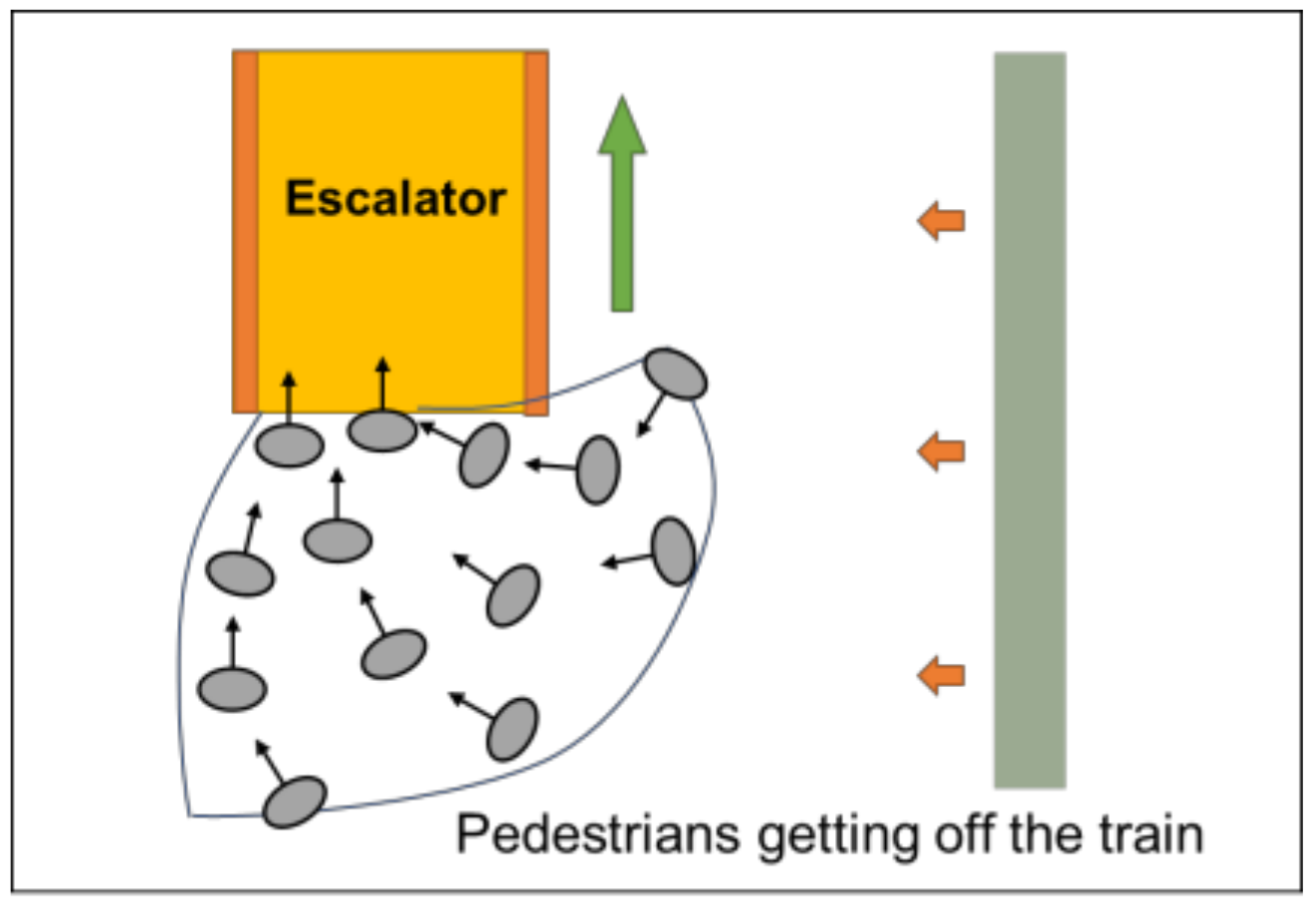
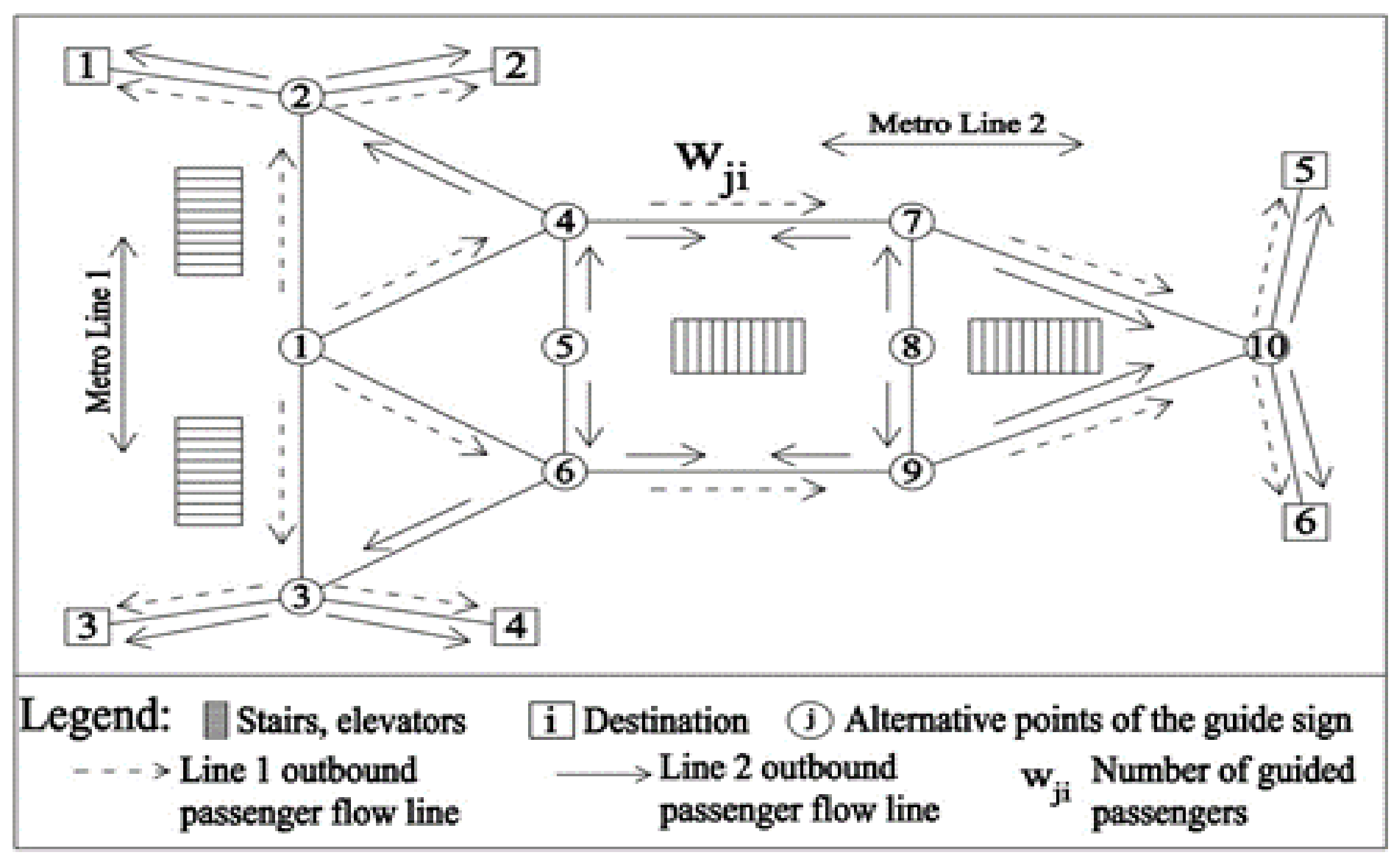
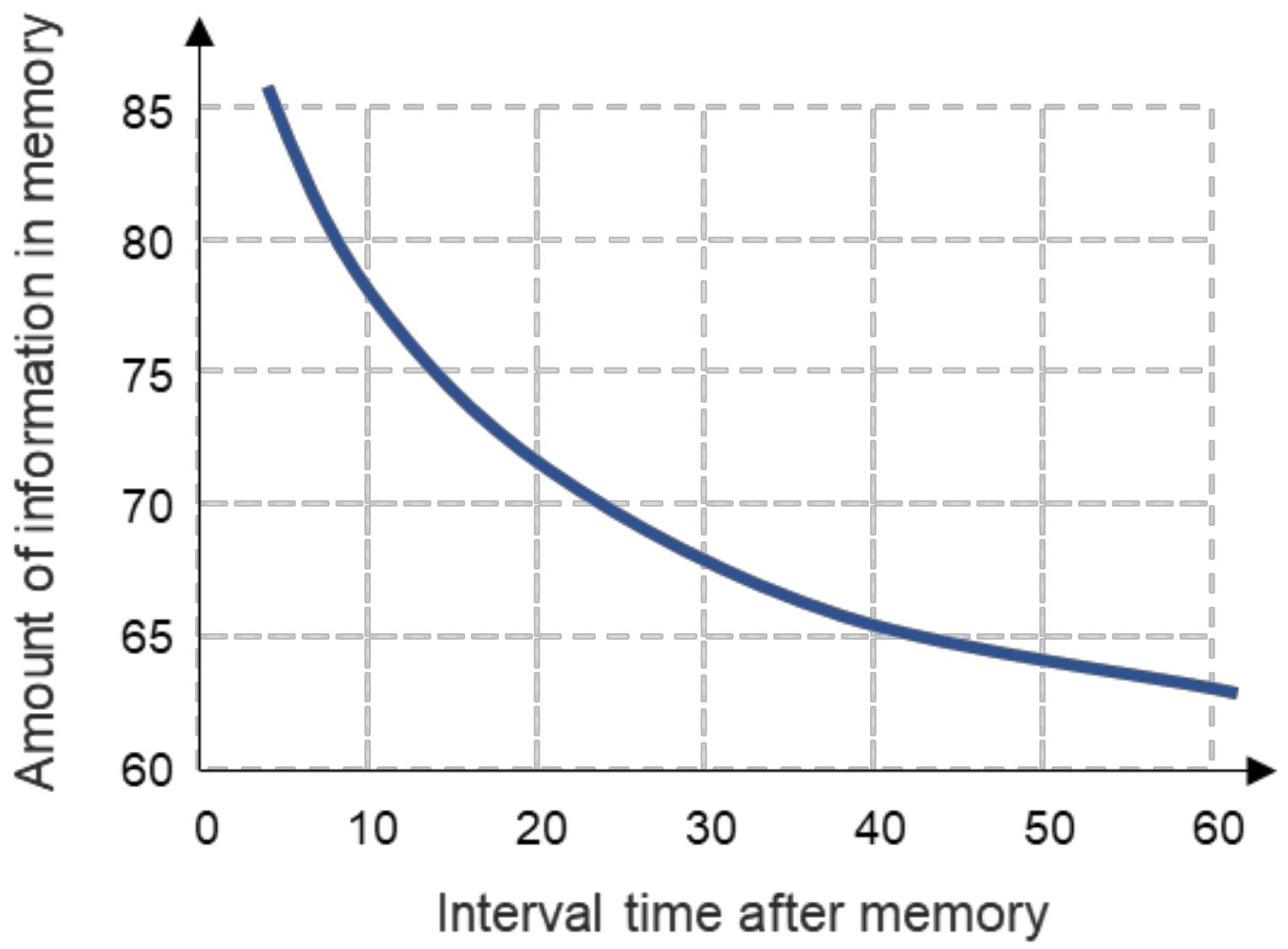



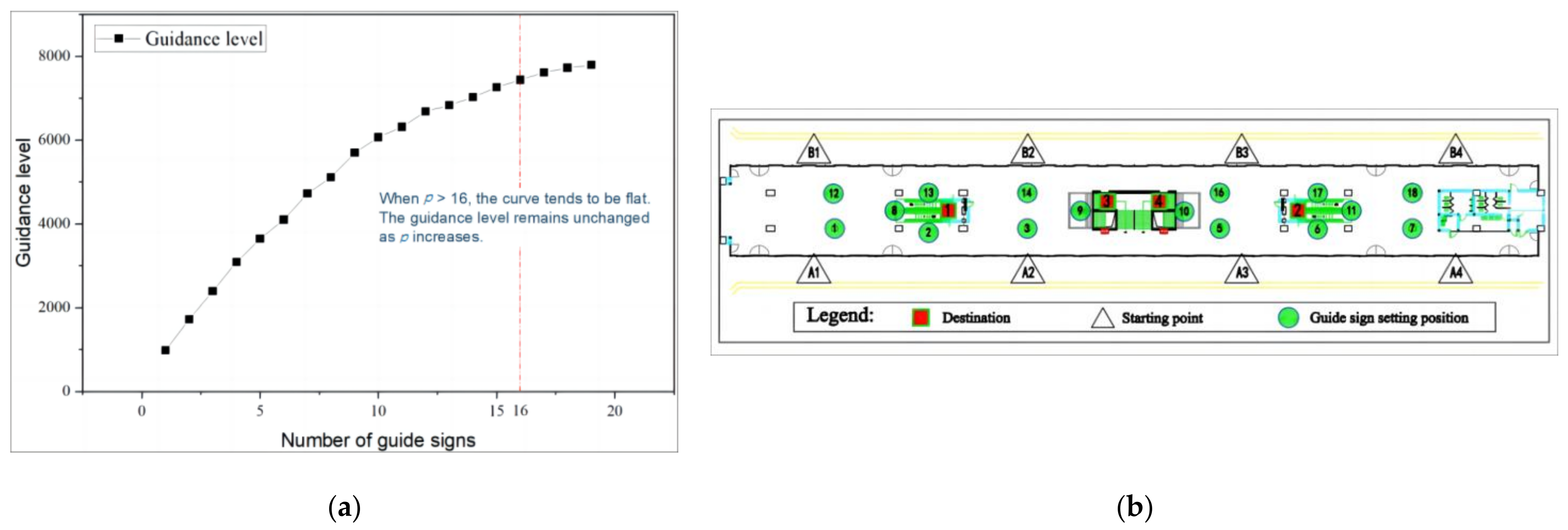
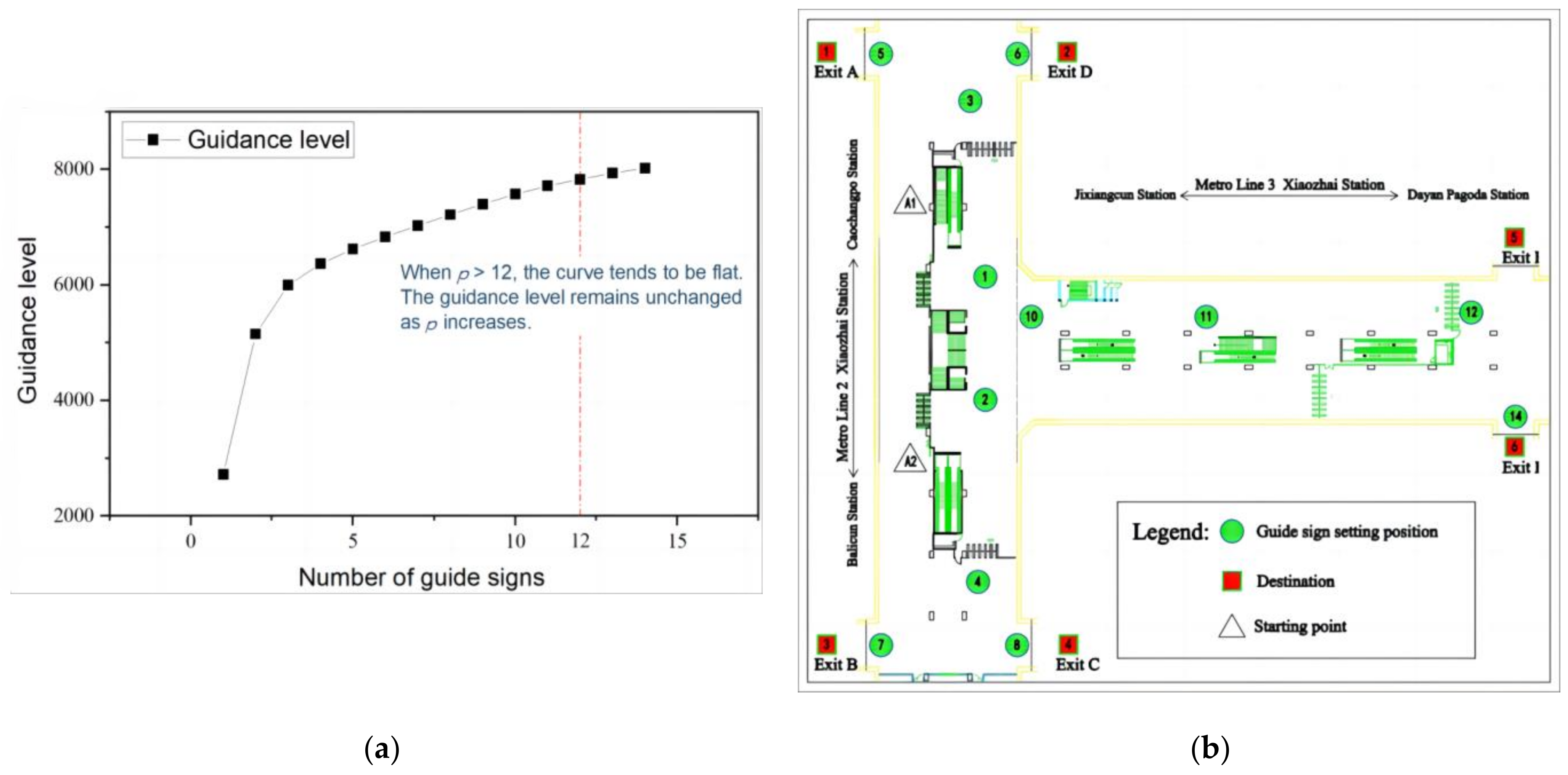
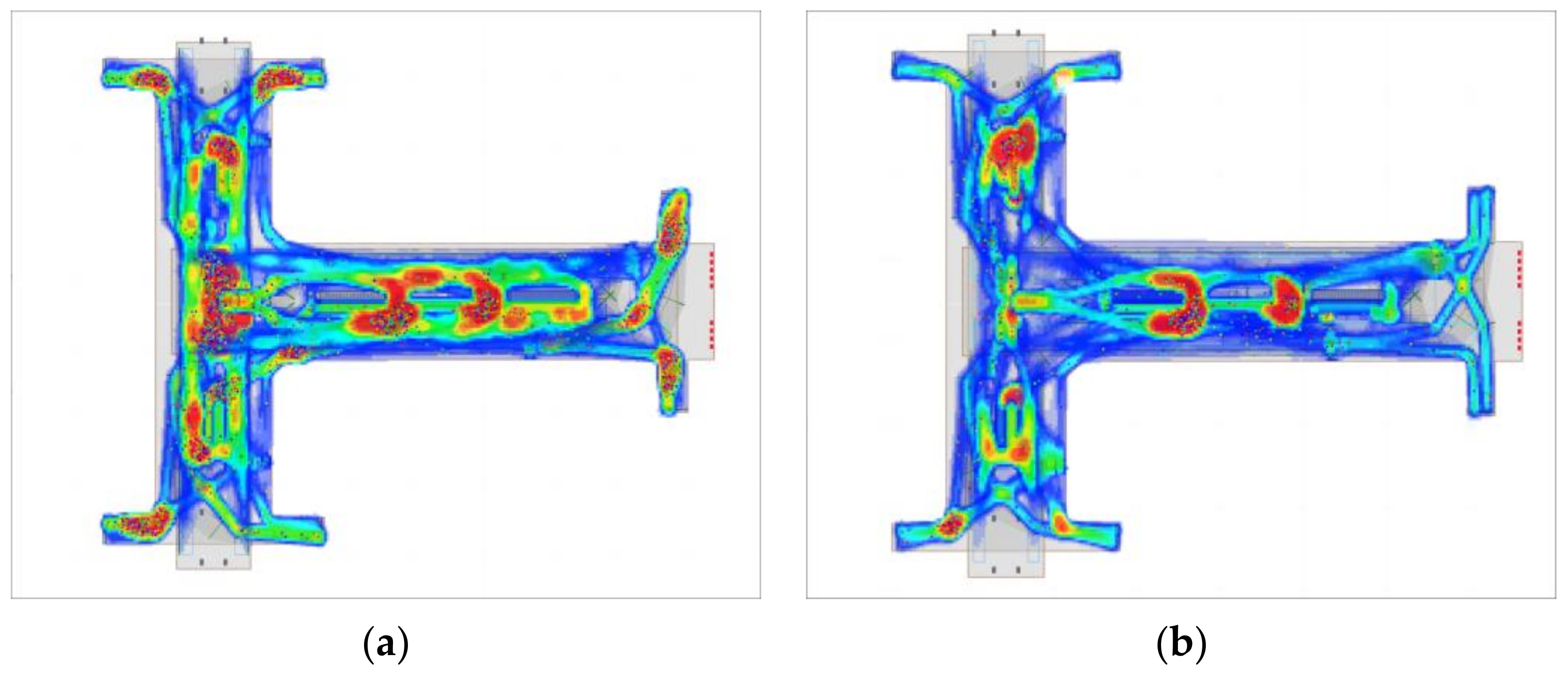

| Age | Gender | Level of Education | Walking Time of Each Space (s) | ||||||
|---|---|---|---|---|---|---|---|---|---|
| Platform | Interlayer Facilities | Station Hall | Horizontal Channel | ||||||
| Stair | Elevator | Open | Semi- Confined Channel | ||||||
| Adjacent Platforms | Non-Adjacent Platform | ||||||||
| 25 | Female | Bachelor | 27 | 40 | 43 | - | 96 | - | 89 |
| 22 | Female | College | 33 | 38 | 74 | - | 82 | 9 | - |
| 37 | Male | High | 29 | - | - | 41 + 27 + 25 | 49 | 16 | 72 |
| 15 | Male | Middle | 8 | - | 37 | 41 | 88 | 13 | - |
| 61 | Female | Primary | 12 | - | 69 | 41 | 119 | - | 93 |
| 31 | Male | Bachelor | 36 | 45 | 52 | - | 62 | - | 47 |
| Location Type | Average Speed | |
|---|---|---|
| Horizontal channel | Open type | 0.85 m/s |
| Semi-closed type | 0.80 m/s | |
| Stairs | Adjacent platform | 0.69 m/s |
| Non-adjacent platform | 0.53 m/s | |
| Station hall layer | 1.21 m/s | |
| Platform layer | 1.35 m/s | |
| Type | Symbol | Definition | Value |
|---|---|---|---|
| Invariant parameters | Weight coefficient | 1 or 1.5 | |
| Time required to reach the maximum distance at position | 15 s | ||
| Time required to reach the minimum distance at position | 3 s | ||
| The average speed corresponding to different positions | Table 1 | ||
| Unknown parameters | Number of crossing points | Obtained by pedestrian tracking experiment | |
| Number of alternative points | |||
| Guided passenger volume |
| Starting Point | Destination | Passed Guided Point | Guided Passenger Volume | Starting Point | Destination | Passed Guided Point | Guided Passenger Volume |
|---|---|---|---|---|---|---|---|
| A1 | 1 | 1, 8 | 130 | B1 | 1 | 12, 8 | 84 |
| 3 | 1, 2, 3, 9 | 68 | 3 | 12, 13, 14, 9 | 78 | ||
| A2 | 1 | 3, 2, 1, 8 | 159 | B2 | 1 | 14, 13, 12, 8 | 149 |
| 3 | 3, 9 | 35 | 3 | 14, 9 | 47 | ||
| 4 | 3, 4, 5, 10 | 13 | 4 | 14, 15, 16, 10 | 20 | ||
| A3 | 4 | 5, 10 | 66 | B3 | 4 | 16, 10 | 67 |
| 3 | 5, 4, 3, 9 | 17 | 3 | 16, 15, 14, 9 | 32 | ||
| 2 | 5, 6, 7, 11 | 137 | 2 | 16, 17, 18, 11 | 135 | ||
| A4 | 2 | 7, 11 | 110 | B4 | 2 | 18, 11 | 131 |
| 3 | 7, 6, 5, 10 | 76 | 3 | 18, 17, 16, 10 | 67 |
| Starting Point | Destination | Passed Guided Point | Guided Passenger Volume | Starting Point | Destination | Passed Guided Point | Guided Passenger Volume | ||||
|---|---|---|---|---|---|---|---|---|---|---|---|
| A1 | 1 | 1, 3 | 5 | 231 | 93 | A2 | 1 | 2, 1, 3 | 5 | 196 | 78 |
| 2 | 6 | 138 | 2 | 6 | 118 | ||||||
| 3 | 1, 2, 4 | 7 | 189 | 92 | 3 | 2, 4 | 7 | 188 | 99 | ||
| 4 | 8 | 97 | 4 | 8 | 89 | ||||||
| 5 | 1, 10, 11, 12 | 13 | 102 | 45 | 5 | 2, 10, 11, 12;2, 9, 11, 12 | 13 | 59; 70 | 15 | ||
| 28 | |||||||||||
| 6 | 14 | 57 | 6 | 14 | 44 | ||||||
| 42 | |||||||||||
| 1 | 1, 3 | , | 130, 68 | 2, 4 |
| 2 | 1, 3 | , | 159, 68 | 3, 3 |
| 3 | 1, 3, 4 | , , | 159, 35, 13 | 4, 2, 4 |
| 4 | 3, 4 | , | 17, 13 | 3, 3 |
| 5 | 2, 3, 4 | , , | 137, 17, 66 | 4, 4, 2 |
| … | … | … | … | … |
| 16 | 2, 3, 4 | , , | 135, 32, 67 | 4, 4, 2 |
| 17 | 2, 4 | , | 135, 67 | 3, 3 |
| 18 | 2, 4 | , | 131, 67 | 2, 4 |
| Time Consumption before Optimization (s) | Time Consumption after Optimization (s) | Time Reduction (s) | Reduction Percentage (s) | |
|---|---|---|---|---|
| departure of Line 2 | 313.89 | 295.38 | 18.51 | 5.90% |
| departure of Line 3 | 305.52 | 296.43 | 9.09 | 2.98% |
| transfer from Line 2 to Line 3 | 184.02 | 180.44 | 3.58 | 1.95% |
| transfer from Line 3 to Line 2 | 311.33 | 296.6 | 14.73 | 4.73% |
Disclaimer/Publisher’s Note: The statements, opinions and data contained in all publications are solely those of the individual author(s) and contributor(s) and not of MDPI and/or the editor(s). MDPI and/or the editor(s) disclaim responsibility for any injury to people or property resulting from any ideas, methods, instructions or products referred to in the content. |
© 2023 by the authors. Licensee MDPI, Basel, Switzerland. This article is an open access article distributed under the terms and conditions of the Creative Commons Attribution (CC BY) license (https://creativecommons.org/licenses/by/4.0/).
Share and Cite
Suo, Y.; Lei, B.; Xun, T.; Li, N.; Lei, D.; Luo, L.; Cao, X. Optimization Method of Subway Station Guide Sign Based on Pedestrian Walking Behavior. Sustainability 2023, 15, 12690. https://doi.org/10.3390/su151712690
Suo Y, Lei B, Xun T, Li N, Lei D, Luo L, Cao X. Optimization Method of Subway Station Guide Sign Based on Pedestrian Walking Behavior. Sustainability. 2023; 15(17):12690. https://doi.org/10.3390/su151712690
Chicago/Turabian StyleSuo, Yifei, Bin Lei, Tianxiang Xun, Na Li, Dongbo Lei, Linlin Luo, and Xiaoqin Cao. 2023. "Optimization Method of Subway Station Guide Sign Based on Pedestrian Walking Behavior" Sustainability 15, no. 17: 12690. https://doi.org/10.3390/su151712690





